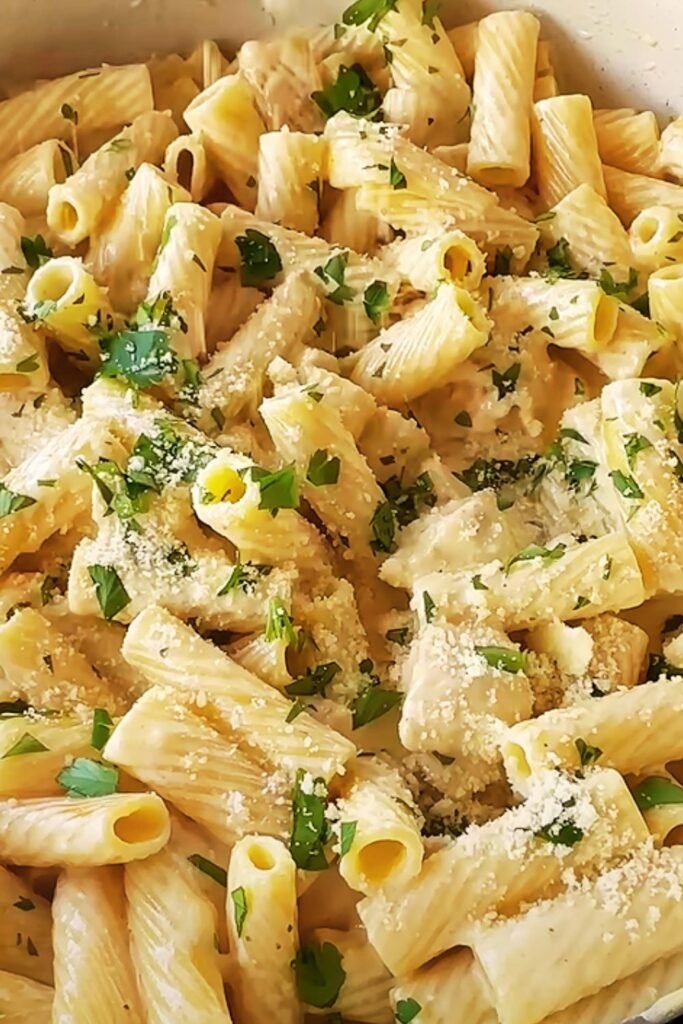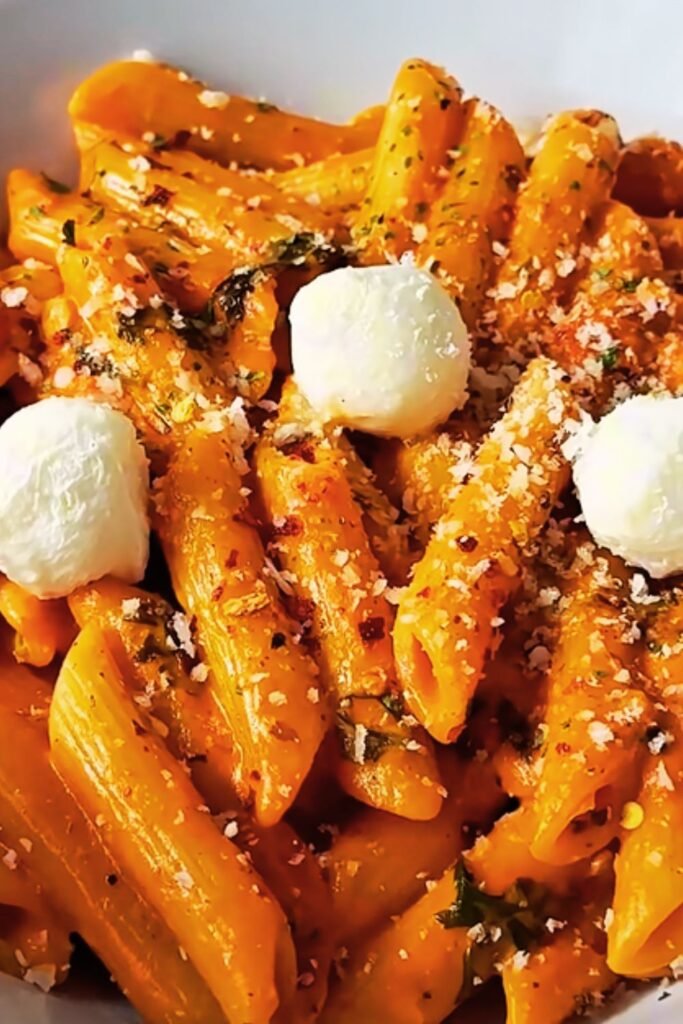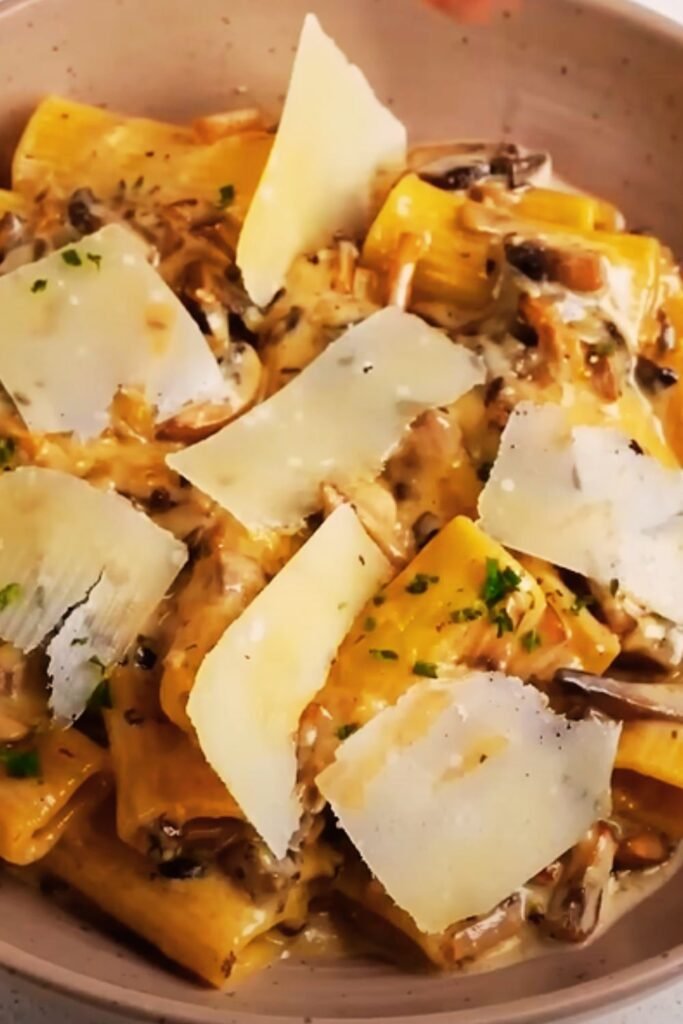There’s something magical about a meal that comes together in a single pot. As someone who values both flavor and convenience, I’ve perfected this One-Pot Garlic Parmesan Pasta recipe over countless weeknight dinners. The combination of al dente pasta, earthy mushrooms, vibrant spinach, and a silky garlic parmesan sauce creates a restaurant-worthy dish with minimal cleanup. Whether you’re cooking for your family or impressing dinner guests, this recipe delivers maximum flavor with minimum effort.
Why You’ll Love This Recipe
When I first started making one-pot pasta dishes, I was skeptical. Could everything really cook properly in a single pot? Would the pasta be too starchy? Would the vegetables get overcooked? After much experimentation, I can confidently say that this recipe overcomes all those challenges while delivering these benefits:
- Time-efficient: Ready in just 30 minutes from start to finish
- Budget-friendly: Uses simple, affordable ingredients
- Versatile: Easy to customize with your favorite vegetables or proteins
- Perfect texture: The pasta absorbs the flavors as it cooks
- Minimal cleanup: Just one pot to wash when you’re done!
The secret lies in the cooking technique. By toasting the pasta briefly before adding liquid, you’ll enhance its nutty flavor. And by adding the vegetables at strategic times, everything finishes cooking at exactly the right moment.
Ingredients and Substitutions
I’ve designed this recipe to be adaptable based on what you have available. Here’s what you’ll need:
| Ingredient | Quantity | Substitution Options |
|---|---|---|
| Fettuccine or linguine pasta | 8 oz (about 225g) | Any long pasta works well; for gluten-free, use rice pasta |
| Olive oil | 2 tablespoons | Butter or avocado oil |
| Garlic cloves, minced | 4-6 cloves (about 2 tablespoons) | 1 teaspoon garlic powder in a pinch |
| Cremini mushrooms, sliced | 8 oz (about 225g) | White button, shiitake, or portobello mushrooms |
| Baby spinach | 4 cups (loosely packed) | Kale, arugula, or Swiss chard (may need longer cooking time) |
| Vegetable or chicken broth | 2½ cups | Water with 1 bouillon cube |
| Heavy cream | ½ cup | Half-and-half or full-fat coconut milk for dairy-free |
| Parmesan cheese, freshly grated | 1 cup + extra for serving | Pecorino Romano or nutritional yeast for dairy-free |
| Red pepper flakes | ¼ teaspoon | Black pepper or omit if sensitive to spice |
| Salt | ¾ teaspoon (adjust to taste) | Reduce if using salted broth |
| Fresh thyme leaves | 1 tablespoon | Dried thyme (1 teaspoon) or Italian seasoning |
| Fresh parsley, chopped | 2 tablespoons | Basil or chives |
| Lemon zest | From half a lemon | Lemon juice (1 tablespoon) added at the end |
Key Ingredient Notes
Pasta: Fettuccine is my go-to for this recipe because its flat, wide shape helps catch the creamy sauce, but linguine, spaghetti, or even penne will work. Just adjust cooking time accordingly.
Mushrooms: I prefer cremini mushrooms for their earthy flavor, but white button mushrooms work perfectly well too. If you’re feeling fancy, a mix of wild mushrooms elevates this dish to gourmet status.
Parmesan cheese: Please, if possible, use freshly grated parmesan rather than pre-packaged. The difference in melting properties and flavor is substantial. I keep a block in my refrigerator and grate it as needed.
Broth: The broth forms the foundation of your sauce. I typically use vegetable broth, but chicken broth adds another dimension of flavor if you’re not vegetarian.
Equipment Needed
One of the beauties of this recipe is its simplicity in terms of equipment:
- Large pot or deep skillet: A 12-inch skillet with high sides or a Dutch oven works perfectly
- Sharp knife and cutting board for prepping vegetables
- Measuring cups and spoons
- Wooden spoon or silicone spatula for stirring
- Cheese grater for the parmesan
- Tongs for serving

Step-by-Step Instructions
Let me walk you through the process of creating this comforting dish:
1. Prepare Your Ingredients
Before turning on the stove, I always prepare my mise en place (everything in its place):
- Slice mushrooms into ¼-inch pieces
- Mince garlic
- Grate parmesan cheese
- Measure other ingredients
This front-loaded preparation makes the cooking process smooth and stress-free.
2. Sauté the Aromatics and Mushrooms
- Heat olive oil in your large pot or deep skillet over medium heat until shimmering
- Add minced garlic and cook for 30 seconds until fragrant (be careful not to burn it)
- Add sliced mushrooms and a pinch of salt
- Cook for 4-5 minutes, stirring occasionally, until mushrooms have released their moisture and begun to brown
Tip: Don’t crowd the mushrooms or they’ll steam rather than brown. If your pot isn’t large enough, cook them in batches.
3. Toast the Pasta
- Break pasta in half if using long noodles (this helps it fit and cook evenly)
- Add dry pasta to the pot with mushrooms and garlic
- Toast for 2 minutes, stirring frequently, until pasta develops a few golden spots
This quick toasting step adds a subtle nutty flavor to the final dish—don’t skip it!
4. Add Liquid and Simmer
- Pour in the broth and add salt and red pepper flakes
- Bring to a boil, then reduce to a simmer
- Cover and cook for 7-9 minutes, stirring occasionally to prevent sticking
- Check pasta for doneness—it should be just shy of al dente as it will continue cooking
Tip: If liquid is absorbing too quickly, add an extra ¼ cup of broth or water.
5. Create the Creamy Sauce
- When pasta is almost tender, reduce heat to low
- Pour in heavy cream
- Add grated parmesan cheese, stirring constantly until melted
- Add fresh thyme leaves
The sauce will look thin initially but will thicken as it stands.
6. Add Spinach and Finish
- Add spinach in batches, stirring until wilted
- Remove from heat once all spinach is incorporated
- Taste and adjust seasonings
- Let pasta rest for 2-3 minutes to thicken sauce
- Finish with fresh parsley and lemon zest
Tip: If sauce becomes too thick, thin with a splash of warm broth.

Nutritional Information
For those keeping track of their nutrition, here’s the breakdown per serving (approximately 1½ cups):
| Nutrient | Amount |
|---|---|
| Calories | 420 |
| Protein | 14g |
| Carbohydrates | 44g |
| Dietary Fiber | 3g |
| Sugars | 3g |
| Fat | 22g |
| Saturated Fat | 10g |
| Cholesterol | 50mg |
| Sodium | 620mg |
| Calcium | 220mg |
| Iron | 2.5mg |
| Vitamin A | 2500IU |
| Vitamin C | 15mg |
Values are approximate and may vary based on specific ingredients used.
Storage and Reheating Instructions
This pasta reheats beautifully, making it perfect for meal prep or leftovers:
Refrigerator Storage
Store in an airtight container for up to 3 days. The pasta will absorb some of the sauce as it sits.
Freezer Storage
While possible to freeze, the texture of the cream sauce may change upon thawing. If you plan to freeze, consider under-cooking the pasta slightly.
Reheating Instructions
- Stovetop (Preferred Method): Add 1-2 tablespoons of water or broth to a pan, add pasta, and warm over medium-low heat, stirring frequently.
- Microwave: Place in a microwave-safe dish with 1 tablespoon of water, cover with a damp paper towel, and heat in 30-second intervals, stirring between each.
- Add Fresh Life: After reheating, add a sprinkle of fresh parmesan and herbs to revive flavors.
Variations and Add-Ins
One of the reasons I return to this recipe again and again is its versatility. Here are some of my favorite variations:
Protein Options
- Chicken: Add 1 cup of cooked, shredded rotisserie chicken when adding the cream
- Shrimp: Sauté 8 oz of peeled shrimp until pink, remove, then add back during the final minute
- White Beans: Add 1 can (15 oz) of drained, rinsed cannellini beans for plant-based protein
Vegetable Variations
- Asparagus: Add 1 cup chopped asparagus during the last 4 minutes of pasta cooking
- Sun-Dried Tomatoes: Add ⅓ cup julienned sun-dried tomatoes (not oil-packed) with the broth
- Broccoli: Add 1 cup small florets during the last 5 minutes of pasta cooking
Flavor Boosts
- Lemon: Add juice from half a lemon at the end for brightness
- Herbs: Try fresh basil, tarragon, or sage instead of thyme
- Cheese Blend: Use half parmesan and half fontina or gruyère for extra creaminess

Serving Suggestions
This pasta is satisfying on its own, but I like to round out the meal with these complementary sides:
Simple Accompaniments
- A crisp green salad with lemon vinaigrette
- Garlic bread or crusty Italian bread for sopping up extra sauce
- Roasted cherry tomatoes drizzled with balsamic glaze
For Special Occasions
- Begin with an antipasto platter featuring olives, artichokes, and roasted peppers
- Serve with seared scallops or a small portion of grilled steak
- Finish with a light dessert like berry sorbet or lemon granita
Troubleshooting Common Issues
Even experienced cooks encounter challenges sometimes. Here are solutions to common issues:
Sauce Too Thin
Problem: The sauce isn’t thickening. Solution: Simmer uncovered for a few extra minutes. If that doesn’t work, mix 1 teaspoon of cornstarch with 1 tablespoon of cold water and stir into the sauce.
Pasta Not Cooking Evenly
Problem: Some pasta is overcooked while some is still hard. Solution: Ensure pasta is fully submerged in liquid and stir more frequently during cooking.
Sauce Separating or Curdling
Problem: The cream sauce looks grainy or separated. Solution: Lower heat before adding cream and cheese. Never let the sauce boil after adding dairy.
Too Salty or Under-seasoned
Problem: The finished dish doesn’t taste balanced. Solution: For too salty, add a squeeze of lemon juice. For under-seasoned, add salt gradually (¼ teaspoon at a time) and taste between additions.
Frequently Asked Questions
After sharing this recipe with friends and family, these are the questions I’m most commonly asked:
Can I make this ahead of time for a dinner party? While best served fresh, you can prepare it up to 2 hours ahead and reheat gently with a splash of broth. Add fresh herbs just before serving.
Is there a dairy-free version? Yes! Use full-fat coconut milk instead of cream and nutritional yeast instead of parmesan. Add 1 tablespoon of white miso paste to replicate the umami flavor of parmesan.
What’s the best type of pot to use? A wide, heavy-bottomed pot like a Dutch oven or deep skillet distributes heat evenly and provides enough surface area for ingredients.
Can I double the recipe for a crowd? Absolutely! Use a larger pot and increase cooking time by about 2-3 minutes.
My family doesn’t like mushrooms. What can I substitute? Try zucchini, bell peppers, or artichoke hearts instead. Add them at the same stage as you would the mushrooms.
Why toast the pasta dry before adding liquid? Toasting adds a nutty flavor and helps the pasta hold its shape better during cooking.
Can I use gluten-free pasta? Yes, but cooking times may vary. Check pasta frequently for doneness and be prepared to adjust liquid amounts as gluten-free pasta often absorbs liquid differently.
Final Cooking Tips
After making this dish countless times, I’ve developed these professional tips:
- Temperature Control: Keep heat at medium-low after adding dairy to prevent curdling
- Pasta Selection: Pasta with texture (like rigatoni) holds sauce better than smooth pasta
- Cheese Grating: Grate parmesan at the last minute for best melting properties
- Rest Period: Allow the finished dish to rest for 2-3 minutes before serving; the sauce will thicken and the flavors will meld
- Taste as You Go: Season incrementally, tasting after each addition
The beauty of one-pot cooking is learning to read visual cues rather than strictly following timing. As you make this dish, you’ll develop an intuition for exactly when each component is perfectly cooked.
This One-Pot Garlic Parmesan Pasta has become my go-to recipe for busy weeknights, impromptu dinner guests, and comfort food cravings. The combination of creamy sauce, tender vegetables, and perfectly cooked pasta never fails to satisfy, and the minimal cleanup makes it all the more appealing. I hope this recipe brings as much joy to your kitchen as it has to mine!